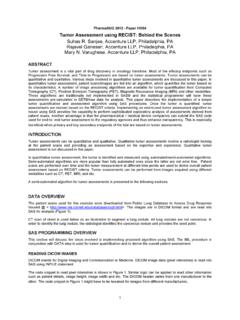Transcription of Cancer Immunotherapy - MEDIAN Technologies
1 Cancer Immunotherapy :Criteria of Assessment with ImagingiRECIST, irRECIST, irRC, MEDIAN TechnologiesWhat is Immunotherapy ?Traditional Chemotherapies Direct killing of tumor cellsInterferes with cell division DNA damaging alkylating agents DNA intercalating agents, anthracyclines DNA synthesis-blocking antimetabolitesImmunotherapiesImmune-med iated cell killingActivates patient s immune system to detect and eliminate tumor cells Vaccines Recombinant cytokines Preformed monoclonal antibodies Immunomodulatory 2 Anti-tumor immune responseCancer-cell antigen presented on APCT cell recognition, activation, responseT cell proliferationT cell migration to tumor siteImmune-mediated tumor cell death CD8+ cytolytic T cells kill tumor cells CD4+ helper T cells secrete cytokinesT cell activation and response are regulated by a balance of stimulatory and inhibitory signals called immune checkpoints, which control the magnitude of 3 Immunotherapy treatment is a 3-step processImmunotherapy Treatment Takes TimeThis process takes time!
2 For treatment of melanoma patients with ipilimumab, it took 30 months to see a complete response This is very unlike chemotherapy treatment, where cell killing/tumor shrinkage is almost immediateAdministration of drug activates immune system = cellular responseCellular response begins to attack tumor cells = anti-tumor responseAnti-tumor response reduces tumor burden and impacts a patient s survival = treatment 4 Novel response patterns for immunotherapies were mapped out using Ipilimumab dataNovel Patterns of response, no new stable after initial tumor burden increases Flare with new lesions[Reproduced with permission Wolchok, 2009] 5 Accurate Evaluation of Clinical ResponseImmunotherapies do not exhibit the same patterns of response as traditional chemotherapiesApplying chemotherapy-based response assumptions to Immunotherapy trials can result in: Inaccurate interpretation of the response Premature termination of therapy Unnecessary removal of patients from clinical 6 Immune-related Response remains the gold standard for evaluating treatment response in solid tumors However, new lesions or flare equals progressive disease under guidelines Inaccurate interpretation of response can result in premature termination of therapy and patient removal from a trialNeed new response criteria Immune-related response criteria (irRC), 2009 Based on WHO criteria Immune-related RECIST (irRECIST), 2013 Combines elements of irRC and RECIST Immune RECIST (iRECIST)
3 , 2017 Standardizes and validates immune response criteria All account for novel response patterns seen with 7iRECIST 2017 Developed by the RECIST working group Standardizes and validates immune response criteria Addresses key questions about tumor assessment with Immunotherapy Resetting the bar if RECIST Progressive Disease (PD) is followed at next time point (TP) by tumor shrinkage New overall response is defined as iUPD orimmune unconfirmed progressive diseaseSeymour et al. Lancet Oncol2017;18 8iRECIST/RECIST 9 RECIST ,non measurable lesionUnchangedDefinition target and non targetUnchangedMeasurement of nodal lesionUnchangedCalculationof sum of diameters (SoD)UnchangedDefinition of CR,PR,SD anddurationUnchangedConfirmation of CR and PRUnchangedDefinitionof progression TL and NTLU nchangedRECIST of new lesionsNew :iSoD sum of diameters for new lesion targetResponse afterRECIST progressionNew:to take into account flare effectConfirmation of progression requiredNew: newdefinition rulesReason why progression cannotbe confirmedNew:must be provided when patient continue in the trialClinical statusNew: takeninto account at clinical evaluation First RECIST PD is iUPD iUPD confirmed 4-8weeks Treatment past PD only considered if patient is clinically stableNew Progression Confirmation Rules: 10iCPD.
4 Immune confirmed progressive diseaseiUPD TL 20% SoDiUPD NTLU nequivocal iUPD NL 5mm SoD Any N LT 5mm iSoD NL NTAny Worsening in lesion categoryWorsening in other lesion categoryiUPD TL 20% SoDNTLU nequivocal NL+++=iCPDiCPD==iCPD++OR==iCPDiCPDiUPD NTLU nequivocal TL 20% SoDNL++ORiCPDiCPD==iCPD = immune confirmed progressive diseaseNTL = non target lesionNL = new lesionNLT = new lesion targetNL NT = new lesion non targetTL = target lesionSoD = sum of diameters for all target lesionsiSod = immune sum of diameters for new lesion targetiUPD = immune unconfirmed progressive diseaseStatistical Considerations iUPD subsequently confirmed The date used is the first UPD date iUPD never confirmed If a subsequent iSD, iPRor iCRis seen, the initial iUPD is ignored Otherwise, iUPD date is 11iRECIST progressionirRC/ irRECIST /iRECISTC omparison All account for delayed response and flare effect by repeat imaging up to 12 weeks after treatment All allow for the presence of new lesionsirRECIST Unidimensional measurements (longest diameter) have been shown to have less variability PD thresholds for irRECIST and RECIST are aligned, allowing for comparisons to be made between trials and to historical data Most trials today evaluate response using irRECIST and RECIST Bidimensional measurements (longest diameter x the longest perpendicular diameter) Rarely used 12iRECIST Unidimensional measurements (longest diameter) PD thresholds for iRECIST and RECIST are aligned Progression confirmation rules are defined Resetting the bar if PD is followed at the next TP by tumor shrinkage (iUPD must occur again)
5 Will be most used going forwardResponse Criteria ComparisonirRCirRECISTRECIST MeasurementBidimensionalUnidimensionalUn idimensionalUnidimensionalBaseline Lesion Size5 mm X 5 mm 10 mm 10 mm 10 mmBaseline Lesion Number10 lesions total, 5 per organ5 lesions total, 2 per organ5 lesions total, 2 per organ5 lesions total, 2 per organAppearance of New LesionsIncorporated into TTBI ncorporated into TTBA lways represents PDiUPDR esponseCR= disappearance of all lesionsPR 50% decrease from baseline TTBSD= when neither PR nor PD can be establishedPD 25% increase in the nadir of TTBCR= disappearance of all lesionsPR 30% decrease from baseline TTBSD= when neither PR nor PD can be establishedPD 20% increase in the nadir of TTB (minimum 5 mm)CR= disappearance of all lesionsPR 30% decrease from baseline TTBSD= when neither PR nor PD can be establishedPD 20% increase in the nadir of TTB (minimum 5 mm)CR= disappearance of all lesionsPR 30% decrease from baseline TTBSD= when neither PR nor PD can be establishedPD 20% increase in the nadir of TTB (minimum 5 mm)Confirmation after first assessmentYe sYes, wait up to 12 weeks to confirm PD to account for flareYes, if response is primary endpointYe s4-8 13iRECIST: Whento use Not treatmentdecision guidelines Internationally agreed recommendations Not yetvalidatedresponse criteria Latephase/approvaltrial RECIST primary criteria iRECIST exploratory criteria Earlyphase ConsideriRECIST as primarycriteriabecause assessment is done via RECIST until progression Uses same thresholds as RECIST at progression iSoD is the only new 14 Thank You!
6 For all more information about how MEDIAN can assist you with your Immunotherapy studies, contact: 15




